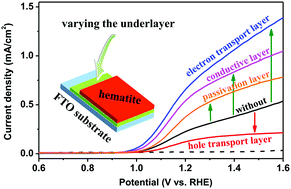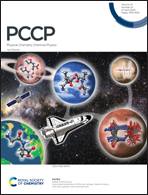Underlayer engineering into the Sn-doped hematite photoanode for facilitating carrier extraction†
Abstract
A semiconductor underlayer(s) has been extensively used to improve the performance of photoelectrochemical (PEC) cells. Unfortunately, in many cases, the incorporation of underlayers leads to degraded system performances. A comprehensive study on the functions and manipulations of underlayers is therefore of high significance for achieving high-performance PEC cells. This study indicates that Sn-doped hematite photoanodes decorated with various underlayer materials show substantially distinguished photocurrent responses, leading to qualitatively different PEC cells. With an optimized TiO2 (ITO, Al2O3) underlayer, the photocurrent density at 1.23 V versus RHE can be enhanced from 0.25 to 0.71 (0.59, 0.42) mA cm−2, while it is decreased to 0.14 mA cm−2 by using NiO. Our further analysis reveals that the performance differences come mainly from the distinguished bulk and surface carrier recombination effects, i.e., (1) metal doping (i.e., Ti4+, In3+ and Al3+) from the underlayers improves the conductivity of hematite film and thus reduces the bulk recombination; (2) the underlayers of TiO2, ITO and Al2O3 can effectively suppress the carrier recombination at the bottom/top surfaces of the hematite layer, while the NiO underlayer leads to a higher surface recombination. Our work provides a basis for selecting an underlayer and a general guideline for the interface engineering for high performance photoelectrodes.



 Please wait while we load your content...
Please wait while we load your content...